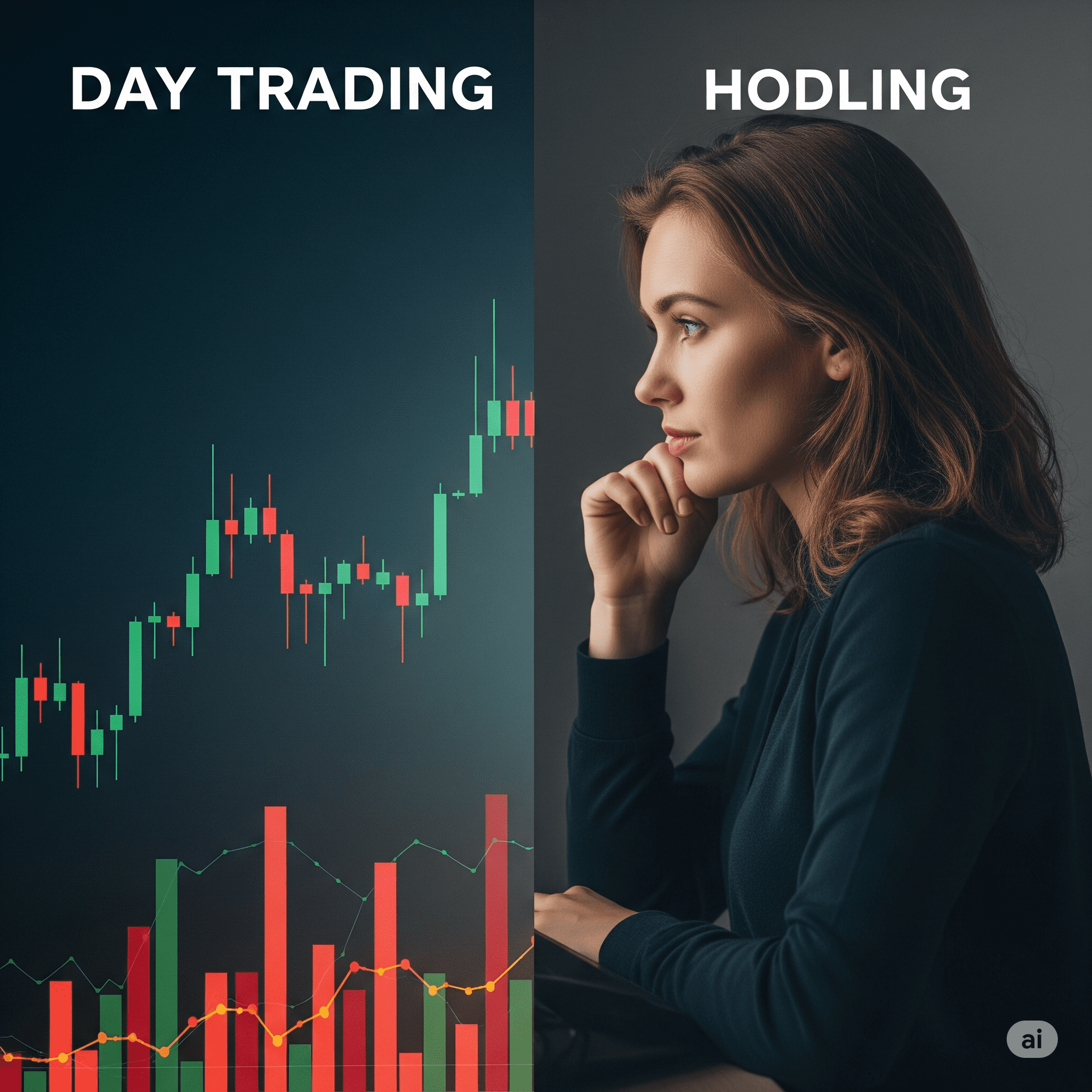In the world of crypto investing, one of the biggest decisions you’ll face is whether to hold your assets long-term or trade them frequently for quick profits. It’s a question that confuses many beginners and choosing the wrong strategy can lead to stress, losses and great missed opportunities. HODLing in Kenya offers a patient, low-maintenance path to long-term gains, while day trading demands constant attention, sharp timing and a high tolerance for risk. So, how do you know which approach fits your personality, goals and lifestyle? In this article, we’ll break down both strategies to help you confidently choose the one that suits you best and show you how you can opt for both of them.

Cryptocurrency hodling
Cryptocurrency hodling is a long-term investment strategy where traders buy and hold cryptocurrencies for a long period of time regardless of the market volatility and fluctuations. The term “HODL” originated from a 2013 forum post where a Bitcoin Talk user misspelled “hold” as “HODL,” and it quickly became a popular acronym for “Hold On for Dear Life.’’ Hodling in Kenya can be a safer strategy for investors, as it favors those who see crypto as a store of value rather than quick profits. This strategy requires discipline and patience as investors ignore the short-term price movements in the market and focus on long-term gains.
Pros of hodling
Here are the main advantages of HODLing cryptocurrency:
i) Simplicity and low maintenance: Hodling is a long-term investment strategy and because of this, you don’t need to constantly watch and monitor market movements or make frequent trades
ii) Less stressful: You don’t need to track price charts or react to the price changes. This makes hodling a better option for investors, as it is a more relaxing and suitable approach to trading.
iii) Avoids emotional trading: Investors who prefer hodling are mostly committed to long-term benefits. They are less affected by panic selling or making decisions out of fear or hype. Patience and discipline are key in this strategy.
iv) Lower transaction fees: Since you don’t frequently carry out trades, you avoid paying high transaction fees and slippage that may eat up the profit.
v) Long-term growth potential: Most cryptocurrencies like Bitcoin and Ethereum, have shown significant growth over time.
Cons of hodling
Some of the key disadvantages of hodling include
i) Missed short-term opportunities: Investors might hold a crypto and miss out on short-term price swings that could generate faster income and profits.
ii) No guarantee of returns and profits: Unlike traditional savings or dividend-paying stocks, most crypto assets don’t offer regular income or guaranteed growth for profits. The price of some crypto may remain flat or even drop permanently.
iii) Emotional stress during volatility: During hodling, you might watch your investment drop and this may be emotional and mentally challenging to investors.
iv) Opportunity cost: Your funds are locked in one or more coins, meaning you might miss better returns from other investments like stocks and real estate.
v) Regulatory and Technological Risks: The crypto space is still evolving. Future regulations, hacks or technological issues could affect the long-term value or utility of the assets you’re holding.
Cryptocurrency day trading
Day trading is a short-term trading strategy where traders buy and sell cryptocurrency within the same day. The goal is to take advantage of the price fluctuations and make profits. It requires a deep understanding of the market and a lot of experience to be successful. Unlike hodling in Kenya which requires patience, day trading involves fast decision-making and constant market analysis. Day traders use
- Technical analysis (candlestick patterns, RSI, MACD, moving averages)
- Real-time market data
- Trading tools or bots
- News alerts and price triggers
This helps traders to identify entry and exit points of the market and ensure risk management when the market is volatile.
Pros of day trading
Below are some advantages of carrying out day trading in Kenya.
i) High potential for quick profits: Due to the volatile nature of crypto markets, day traders capitalize on their price swings to earn profits within a few seconds or minutes. With good strategy and timing, profits can accumulate quickly.
ii) Frequent trading opportunities: Unlike traditional markets, crypto trading is 24/7. That means more opportunities, no matter your time zone or schedule. Events like token listings and partnerships can trigger profitable trades at any moment.
iii) Full control over your portfolio: As a trader, you are the one managing your own funds, deciding when to enter and exit the market based on your strategy. This hands-on approach gives you more control and agility compared to long-term investors who must ride out bear markets.
iv) Profit in any market direction: By using techniques like short selling or trading inverse pairs, traders can benefit from market declines, something long-term holders cannot. For instance, a trader might short Bitcoin when it’s overbought and falling and then buy it back at a lower price for profit.
vi) Sharpened Trading Skills: Day trading involves constant chart analysis, decision making and news tracking. This forces you to improve your skills and understanding of the market behavior. Over time you will gain more experience and develop a good understanding of the market trends and technical analysis. All these gains will help you within and beyond crypto.
Cons of day trading
While day trading can be exciting and potentially profitable, it also comes with significant downsides. These downsides include
i) High risk of losses: crypto markets are volatile and unpredictable. Because of this a wrong move or poorly timed trade may lead to loss of funds. If a trader is using leverage in their trades, it may magnify rapidly. Many new traders blow up their accounts before developing a solid strategy.
ii) Adds up trading fee: on high-frequency trading platforms like Binance and Coinbase, the fee may seem small but due to frequent trades, it may eat up or reduce your profit margin. If you’re trading in smaller volumes, these fees can significantly eat into gains, especially in tight market conditions.
iii) Emotionally and mentally draining: day trading involves constantly monitoring price and market trends for any price movements. Watching charts all day and making high-stakes decisions is mentally exhausting. This may lead to the pressure to act fast and the fear of missing out (FOMO) and this triggers trading mistakes. A trader then decides to do some additional trade to cover the loss, leading to overtrading, which causes significant losses.
iv) Requires time and attention: a trader must monitor market charts, analyze indicators and react quickly to price swings. Some mistakes, like missing a trade and going offline, may lead to missed trading opportunities. This makes it unsuitable for people with busy schedules.
v) Steep Learning Curve: Day trading isn’t something you master overnight. It takes months of study and practice to develop a strategy that works for you. Mistakes are common—from misreading a chart to placing a trade too late. Without proper education and discipline, many beginners lose money before they ever break even.
Comparing Risks and Rewards: HODLing vs. Day Trading
The choice between day trading and HODLing in Kenya often comes down to the risk tolerance, time commitment, and financial goals of the trader. Here’s a clear and insightful comparison of the risks and rewards of HODLing vs. day trading in cryptocurrency.
|
Which strategy is right for you?
Whether you should HODL or day trade during a crypto market cycle depends largely on the market trend and your personal strategy.
In a bull market, HODLing is often the safer and more profitable approach as prices generally trend upward, so holding strong assets like Bitcoin or Ethereum allows you to ride long-term gains without stressing over timing every move in the market. However, experienced traders may take advantage of volatility by day trading to lock in frequent profits, especially during short-term pullbacks.
In a bear market, day trading can be more effective if you know how to profit from small price movements or short-selling opportunities, since holding through a downtrend can lead to major unrealized losses. That being said, long-term HODLers with strong conviction in quality projects may choose to accumulate at lower prices and wait for the next cycle. Additionally, your decision should align with your
- Risk tolerance.
- Time commitment.
- Market experience.
- Emotional discipline.
Can you combine both strategies?
Yes, it is possible, as many investors use a hybrid strategy combining both approaches in their trading to reduce risk by diversifying their approach and capitalizing on daily or weekly price fluctuations. If done correctly, combining the two can lead to significant profit margins in both the short term and long term. It is crucial to do your own research, invest only what you can afford to lose and stay informed on the market trends.
FAQs
Who is HODLing recommended for?
HODLing in Kenya is ideal for long-term investors who believe in the future growth of a cryptocurrency and prefer a low-stress, hands-off strategy. It suits those who can tolerate market volatility without reacting emotionally.
What is the best strategy for day trading?
Here are five effective day trading strategies in Kenya:
- Scalping—Focuses on making multiple small profits throughout the day by exploiting tiny price movements.
- Momentum Trading—Involves buying assets that are moving strongly in one direction with high volume.
- Breakout Trading – Entering trades when the price breaks through key support or resistance levels.
- Range Trading—Buying at support and selling at resistance within a sideways-moving market.
- News-Based Trading—Capitalizes on market volatility caused by economic news, announcements, or events.
Is it better to day trade or hold?
It depends on your goals, risk tolerance and experience. Day trading offers quick profits but requires time, skills and high risk management. HODLing suits long-term investors who prefer lower stress and believe in gradual asset growth.
Conclusion
Both HODLing and day trading are legitimate strategies in the crypto world, but they cater to different types of investors.If you’re looking for a low-stress, long-term approach, HODLing strong assets through market cycles may align with your goals.On the other hand, if you’re skilled in technical analysis and enjoy fast-paced decision-making, day trading can offer quick profits but with higher risks.
Ultimately, the best strategy is the one that fits your risk appetite, lifestyle and experience level. In fact, combining both strategies—hodling a core portfolio while trading a small portion—can give you the best of both worlds. Just remember: research thoroughly, manage your risks and invest only what you can afford to lose.

